Cereus Cactus 101: A Visual Tour of 16 Prominent Species
Cereus cacti are a group of more than 30 plant species in the Cactaceae family. They have a unique ability to survive in dry environments. These cacti have tall, columnar stems covered in sharp spines and noticeable ridges. They also produce large flowers. Some popular types of Cereus cacti include Cereus peruvianus, Cereus spiralis, and Cereus hexagonus.
Originally from South America, Cereus cacti are commonly grown as indoor plants. One interesting fact about these cacti is that their flowers only bloom at night.
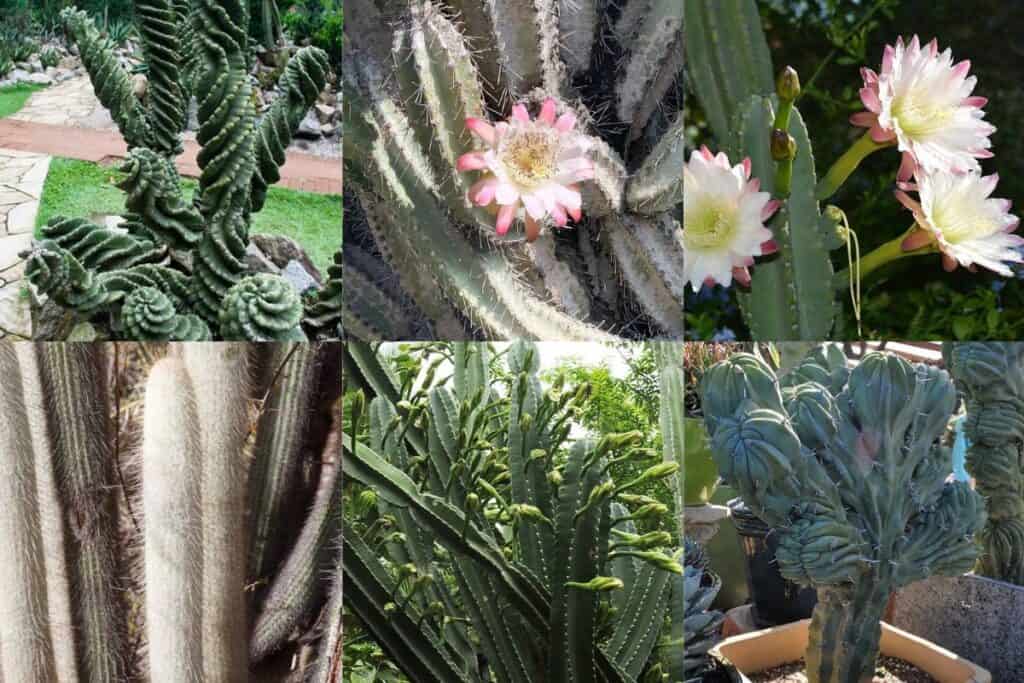
Contents
- 1 Cereus Cactus Types
- 1.1 Cereus aethiops
- 1.2 Cereus dybowskii
- 1.3 Cereus flagelliformis
- 1.4 Cereus forbesii
- 1.5 Cereus forbesii cv. Spiralis (Spiral Cereus)
- 1.6 Cereus hankeanus
- 1.7 Cereus hexagonus (Lady of the Night Cactus)
- 1.8 Cereus jamacaru
- 1.9 Cereus kroenleinii
- 1.10 Cereus lanosus
- 1.11 Cereus nudiflorus
- 1.12 Cereus peruvianus (Hedge Cactus)
- 1.13 Cereus peruvianus ‘Monstrosus’
- 1.14 Cereus spegazzinii (Moonlight Cactus)
- 1.15 Cereus stenogonus (Narrow-angled Cereus)
- 1.16 Cereus versicolor
- 2 Cereus Cactus Care
- 3 Frequently Asked Questions
Cereus Cactus Types
There are a total of about 33 different types of these cacti, but they are not recommended for home use. Among the well-adapted Cereus species with low care requirements are:
- Cereus jamacaru
- Cereus peruvianus
- Cereus peruvianus monstrose
Cereus aethiops
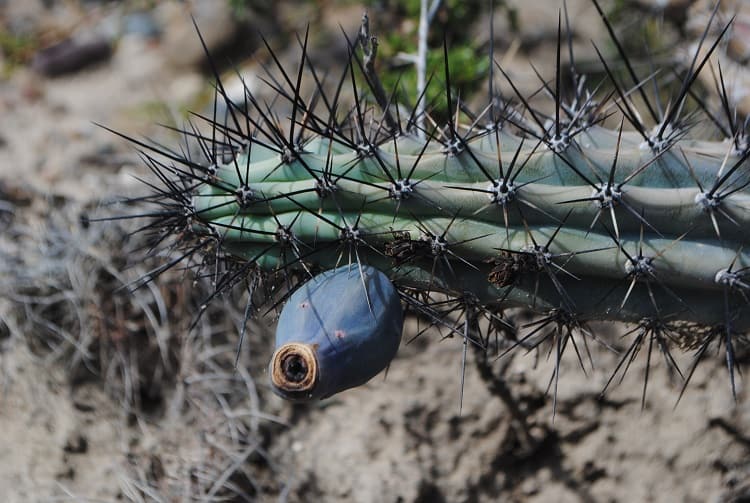
Cereus aethiops is a shrubby cactus that grows upright, with columnar stems. It can sometimes spread out on the ground and branches a lot from the base. It can grow up to 6 feet tall and 5 feet wide. The young stems have a blue waxy coating and unique black spines. It is one of the few Cereus varieties that can flower when small, producing fragrant white to pale pink flowers that are about 8 inches long.
Cereus dybowskii
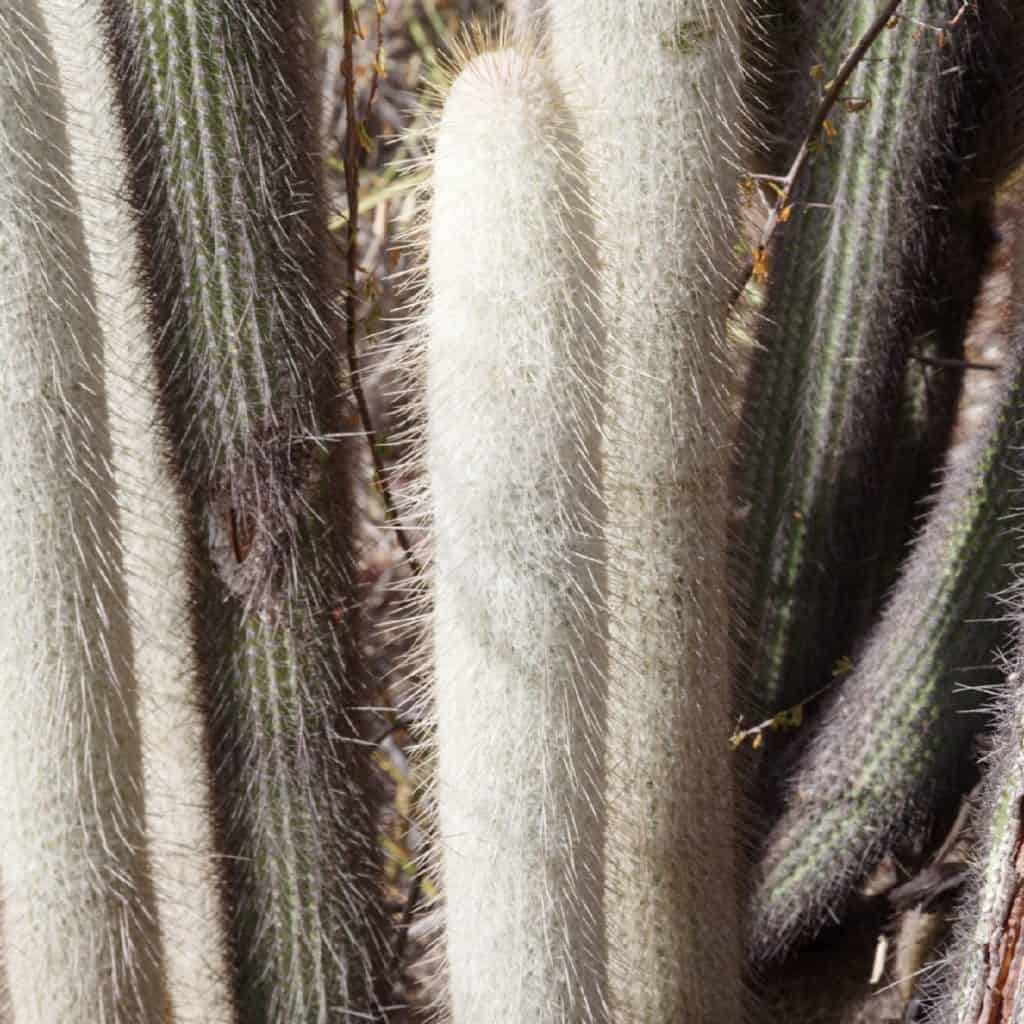
Cereus dybowskii, also known as Espostoopsis dybowskii, is originally from Brazil. It is a slow-growing plant with fine spines and white hair. It is also called Cephalocereus dybowskii, Austrocephalocereus dybowskii, and Coleocephalocereus dybowskii.
Cereus flagelliformis
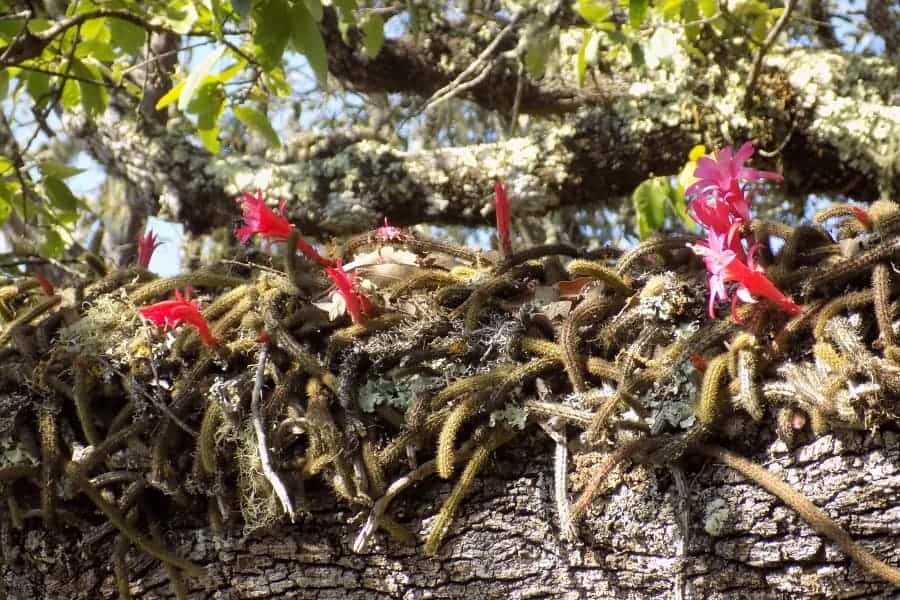
The creeping cereus, also known as Cereus flagelliformis, is mainly found in parts of South America and the West Indies. This cactus tends to grow in a downward direction and eventually creeps along the ground. Each stem has small ribs with spines growing from them. The flowers are pink and usually bloom in June.
Cereus forbesii
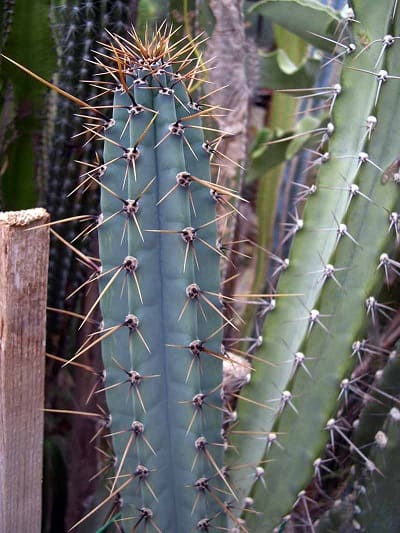
Cereus forbesii is a densely branched shrubby or treelike cactus with blue-green cylindrical stems covered in long spines. It can reach a height of about 6.5 feet (sometimes taller) with a distinct trunk up to 16 inches in diameter. In spring to early summer, it produces large white or pinkish white funnel-shaped flowers with reddish exteriors.
Cereus forbesii cv. Spiralis (Spiral Cereus)
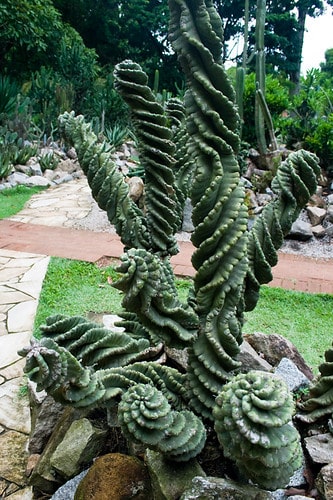
The spiral cereus (Cereus forbesii cv. Spiralis) is a shrubby or treelike species that is considered a mutated form of Cereus forbesii. It usually doesn’t have a trunk and instead forms numerous tall, upward-growing columnar stems that branch out at the base. The stems have a waxy coating and can reach a height of 6.5-13 feet (but can grow even taller) with a diameter of 4-5 inches.
It has 5-9 widely spaced ribs and produces large purple fruits when pollinated. It cannot reproduce on its own.
Cereus hankeanus
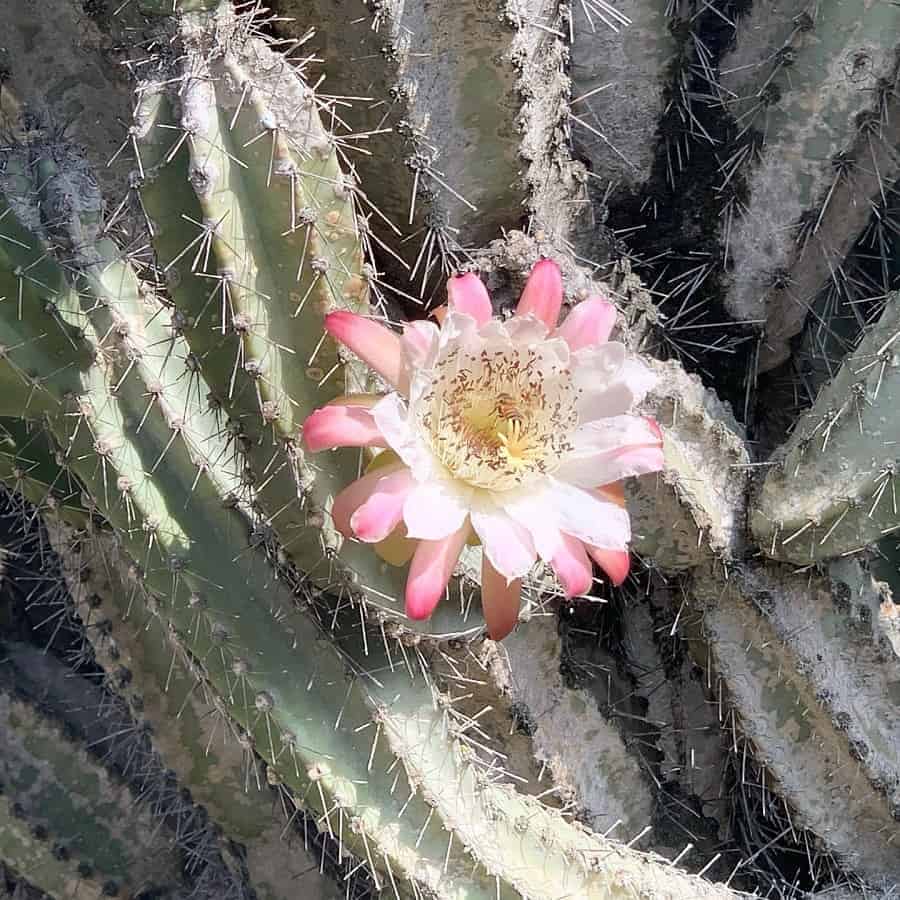
Cereus hankeanus is mainly found in Bolivia and other parts of South America. It is also known as Piptanthocereus hankeanus. This cactus resembles a tree and has columnar blue-green branches with several spines. It can grow up to 12 feet tall and flowers in pink, white, and brownish colors during summer.
Cereus hexagonus (Lady of the Night Cactus)
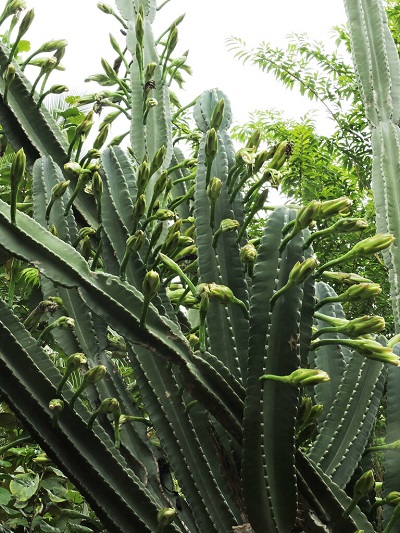
Cereus hexagonus is a tree-like cactus that grows like a candelabrum. It has a short, thick trunk from which cylindrical shoots emerge and rise straight up to 50 feet high. The stems have a fluted appearance and are almost touching each other. It has 5-9 widely spaced ribs.
Cereus jamacaru
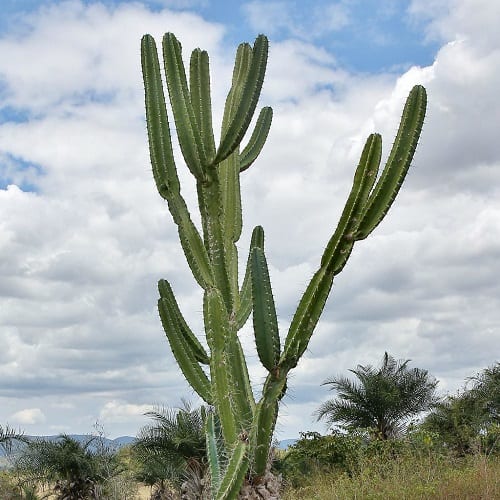
The columnar cactus Cereus jamacaru usually has a single stem at the base and a bluish-green color. When grown indoors, it rarely branches. It has 6-10 pronounced ribs with deep, narrow incisions. The areoles, which sit on the ribs, have 7-8 yellow-brown thorns that are 0.8-0.9 inches long. The flowers, which can grow up to 12 inches long, develop rarely and only on older and larger plants.
Cereus kroenleinii
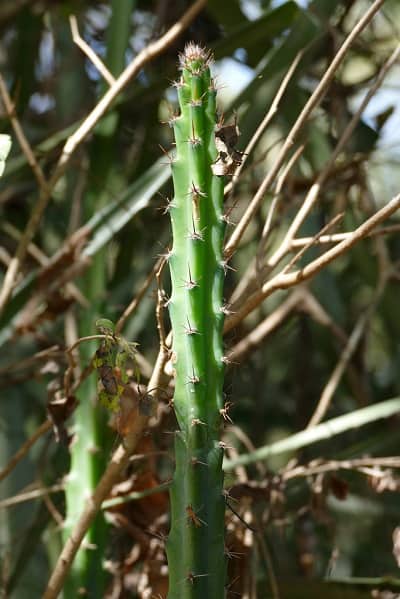
Cereus kroenleinii is a shrubby cactus with thin and flexible branches that stand erect among other vegetation. It can also creep and form tangled clumps up to 6.5 feet tall and 20 feet wide.
Cereus lanosus
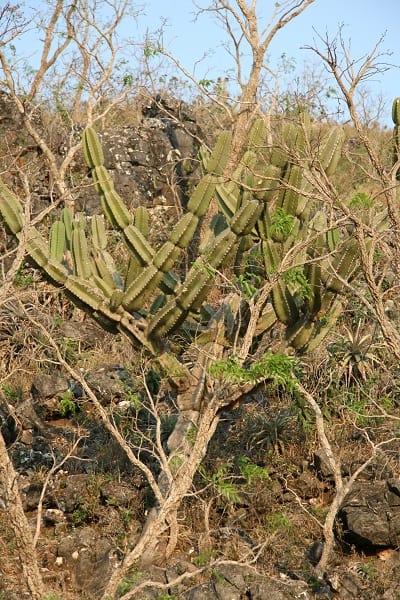
Cereus lanosus is a shrubby, much-branched cactus that grows up to 4.9 feet tall. It is not commonly seen in cultivation but is easy to grow, propagate, and produces numerous showy white flowers.
Cereus nudiflorus
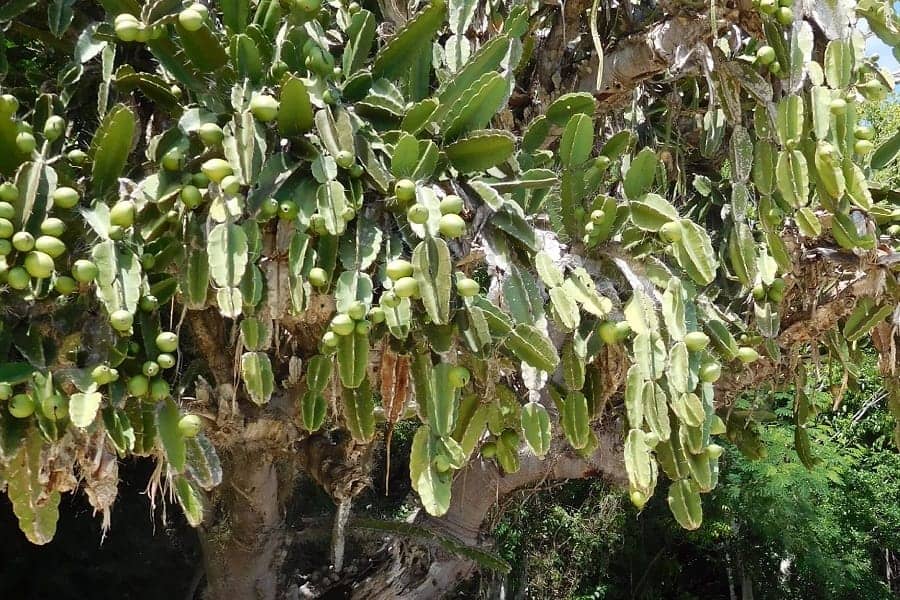
Cereus nudiflorus, also known as Dendrocereus nudiflorus, is also called aguacate cimarrón. It is native to Cuba and is considered the tallest cactus tree in the country, growing up to 42.6 feet tall in coastal areas.
Cereus peruvianus (Hedge Cactus)
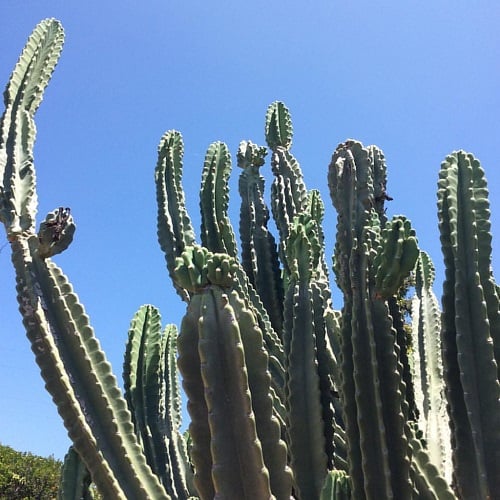
The Cereus peruvianus, also known as Peruvian Apple Cactus or Hedge Cactus, is very similar to the variety ‘jamacaru’. It has 5-8 ribs and 7-8 brownish thorns on its areoles. Its flowers are up to 6 inches long, white inside, and red on the outside.
Cereus peruvianus ‘Monstrosus’
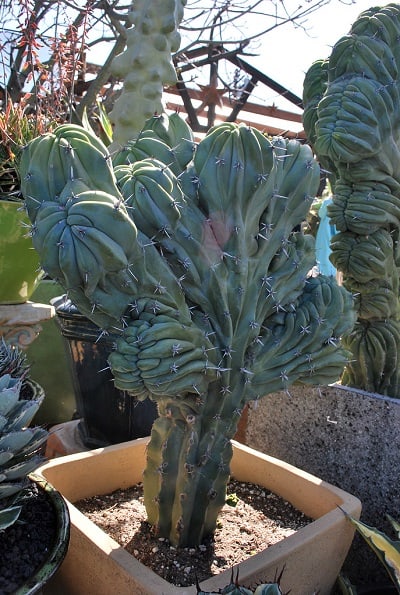
The variety ‘Monstrosus,’ also known as Monstrose Apple Cactus, is popular among cactus collectors. Unlike other species, it has several points where growth occurs, producing flowers, side shoots, and even leaves. This results in a gnarled, irregular shape. It is sensitive to unfavorable growing conditions.
Cereus spegazzinii (Moonlight Cactus)
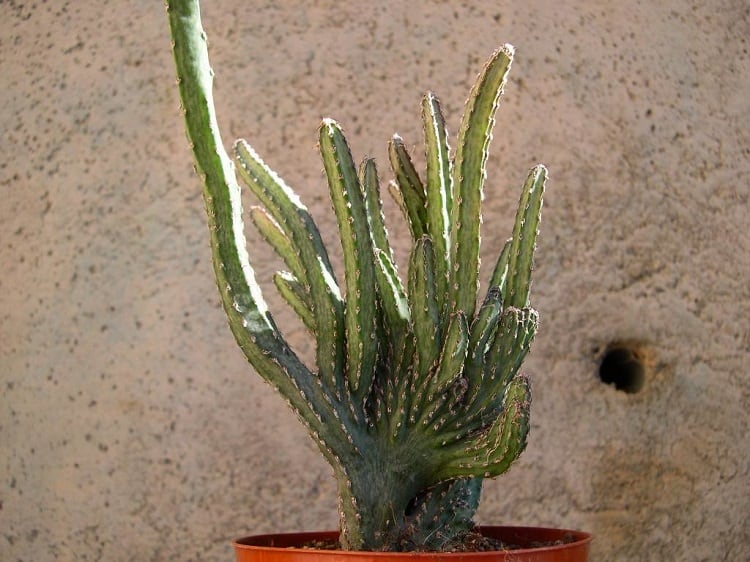
Cereus spegazzinii, also known as Monvillea spegazzinii, is a slender shrubby cactus that is similar in form and habitat to the night-blooming cereus. It produces many basal shoots, quickly forming a clump.
Cereus stenogonus (Narrow-angled Cereus)
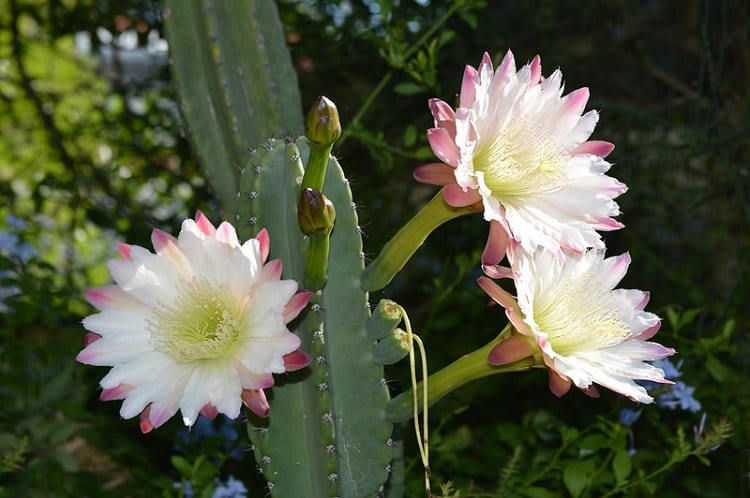
Cereus stenogonus is a tall, tree-like columnar cactus with erect stems reaching 20-26 feet (6-8 meters) high. It can have many branches or be nearly simple. It is naturally found in Argentina, Paraguay, and Uruguay. Its spines are short, conical, and yellow with black tips, or completely black, ranging from 0.2-0.3 inches long.
Cereus versicolor
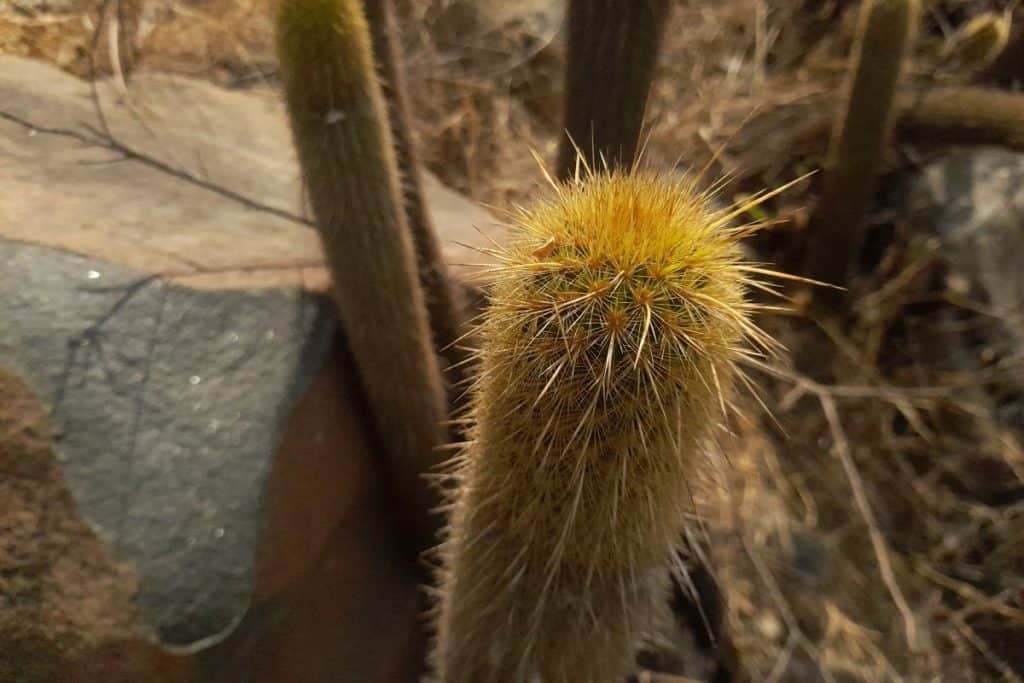
Cereus versicolor, also known as Haageocereus versicolor, is native to multiple regions in Peru. It grows as a cylindrical central stem that branches out into smaller stems. The stems are light green with several ribs and sharp spines, displaying colors of gold, white, and yellow.
Cereus Cactus Care
To ensure that your Cereus cactus thrives and blooms beautifully, there are a few important care tips to keep in mind. It’s relatively easy to grow these cacti, but they do require some specific attention.
- Suitable Temperature: Cereus cacti should not be exposed to temperatures below 50°F (10°C). They need direct sunlight and should be placed in areas with intense light, avoiding shaded spots. While they prefer airy environments, avoid exposing them to direct cold drafts.
- Watering and Humidity: Excessive humidity can be detrimental to these cacti and may even lead to their death. It’s better to water them generously in one go, making sure the water reaches the soil rather than directly watering the cactus itself. During warm seasons, water only when the soil is completely dry. In cold seasons, watering should be done very sparingly to prevent waterlogging.
- Well-Drained Soil: The substrate should be permeable and well-drained to prevent excessive moisture that can harm the plants. For planting, it’s recommended to use a mixture of compost or peat with two parts of soil and one part sharp sand for improved drainage.
- Fertilization: Use a standard flower or cactus fertilizer during the main growing period. Make sure to dilute it properly according to the instructions to avoid over-fertilization.
- Pest Control: To prevent fungi and mealybug infestations, it’s advisable to fumigate the plants twice a year. This helps maintain their overall health and vitality.
Dormancy
During the winter dormant period, Cereus cacti require very little watering. It’s important to ensure that the cactus substrate doesn’t dry out completely during this time.
Temperature
In winter, it’s ideal to keep Cereus cacti in a cool place with temperatures around 50°F (10°C). These cacti can tolerate temperatures as low as 32°F (0°C).
Soil / Substrate
For cultivating these cacti, you can use a soil mixture containing compost or peat. To improve drainage, add one part of sharp sand to two parts of the soil mixture.
Fertilization / Nutrient needs
Only during the main growing period is the cactus given a normal flower or cactus fertilizer. The concentration of the fertilizer should not be too high.
Propagation and Growth
Cereus cacti grow rapidly and can reach heights of up to 50 feet (15 meters) under optimal conditions. They can be propagated either by seeds or by stem cuttings. When using cuttings, plant them in a mixture of 50% peat and 50% sand, ensuring the compound remains slightly moist, at a suitable temperature, and receives enough light.
Repotting
Due to their fast growth, Cereus cacti should be repotted into slightly larger pots about once a year. In early spring, carefully remove the cactus from its current pot and check if the roots are well established. If so, place the cactus in a larger pot with fresh soil, taking care not to damage or break the roots.
Pests
During winter, the hot, dry air can attract mites. Look out for cobwebs in the leaf axils and on leaf edges, as these are signs of mite infestation. Additionally, mealybugs may appear on Cereus cacti, creating a visible white, cotton-like mass.
Frequently Asked Questions
Is cereus cactus poisonous?
Since the Cereus cactus thrive as succulents, the plants have created large supplies of water in their stems. Thus it is mainly cell water that flows out of the wounds after being cut. It does not contain any toxic substances.
However, you should not take a skin injury from the sharp thorns lightly. As with any other injury, there is an increased risk of infection even with the smallest wound. You should therefore also carefully clean small scratches and disinfect them with iodine ointment. As a preventive measure, we recommend that you always approach the well-fortified plants with thorn-proof gloves when doing all planting and care work.
How often should I water my Cereus cactus?
During the growing season, water the Cereus cactus moderately—the soil must always dry slightly between watering.
During the rest period in winter, water very little and only make sure that the substrate of the cactus does not dry out completely.
